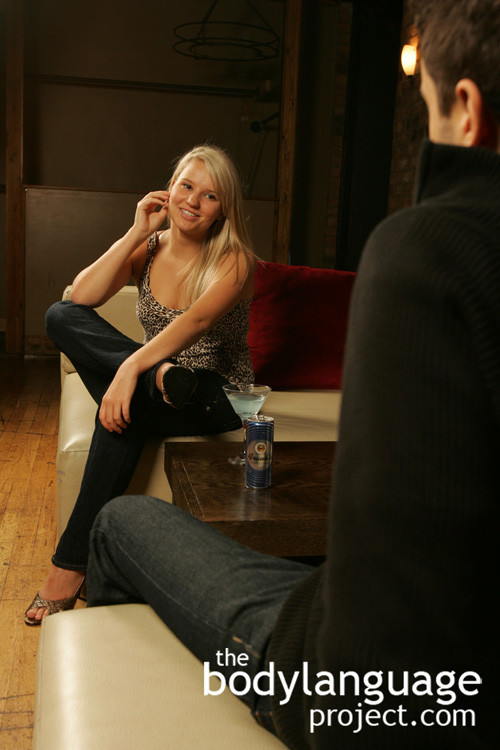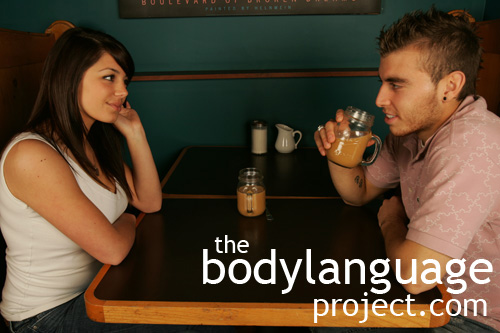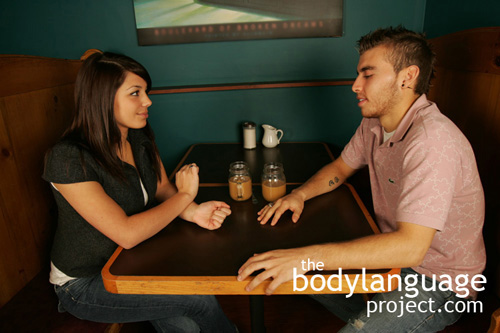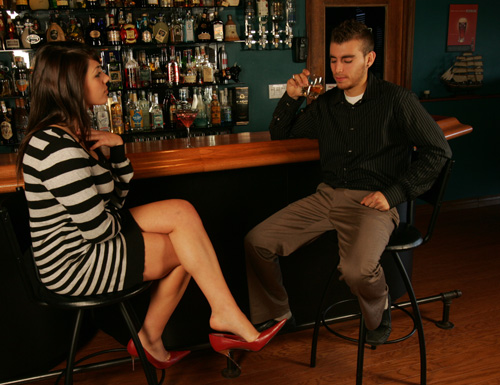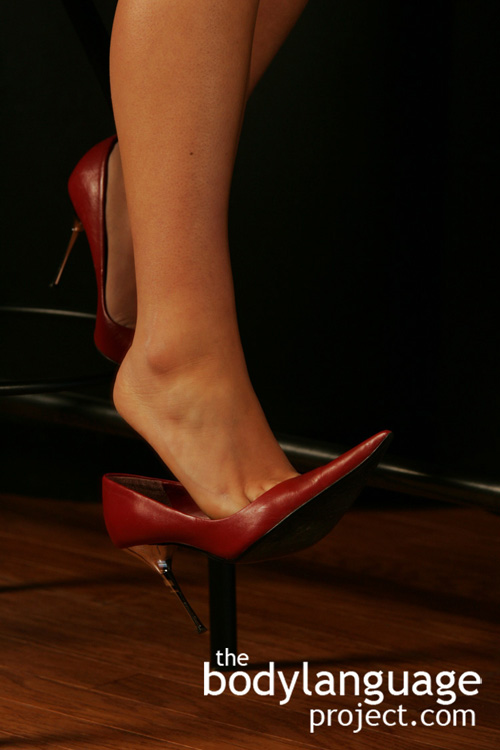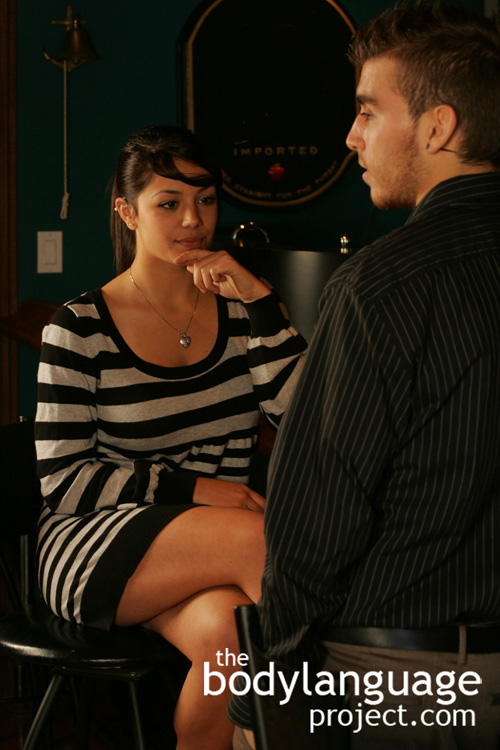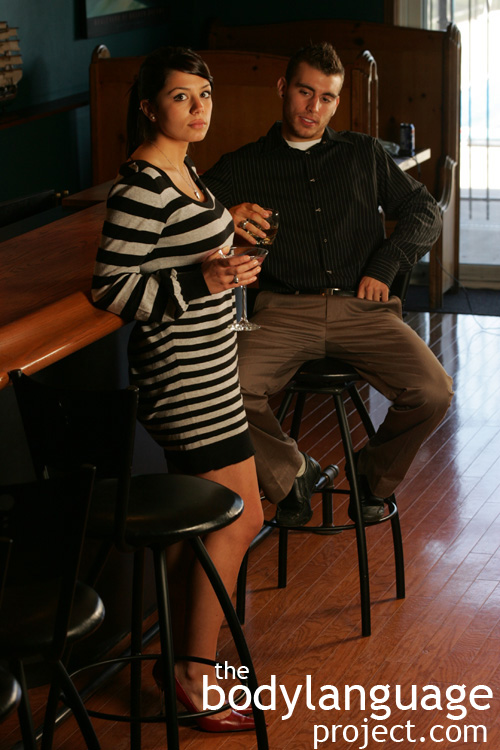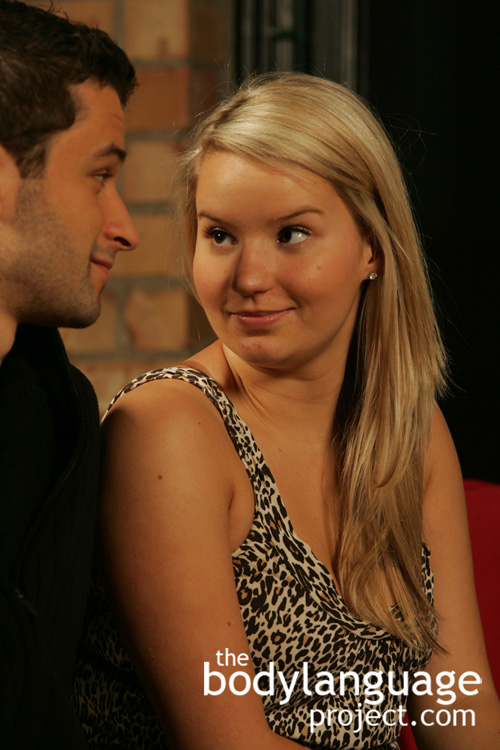Body Language of Wrist Exposure Displays
Synonym(s): Showing The Wrist, Displaying The Wrist, Stroking The Wrist, Exposing The Wrists.
Description: Removing clothing, stroking the wrist, turning the palms up, or playing with an earring that causes the wrists to be exposed.
In One Sentence: Showing the wrist is a female posture signaling submission.
How To Use it: The wrist signal is a female or feminine posture that women (and possibly gay men) use to signal submission. The wrists are a vulnerable part of the body and like the neck, when displayed, signal that a person is willing to heed to the dominance of another. Women can flash the wrist by turning the hands palm up, or lightly stroke the wrists with an index finger. This is not particularly noticeable to men, however, if done correctly, it will elicit a subconscious attraction response in him at a low cost to you.
Context: Dating.
Verbal Translation: “I wish to submit to your dominance so I’m exposing my delicate and vulnerable wrists.”
Variant: See Neck Exposure.
Cue In Action: She frequently fiddled with her earring or her wristwatch while on her date. This helped calm herself, as she was excited just being around him.
Meaning and/or Motivation: Exposures of the wrist, palm and neck are visceral responses linked to submissiveness and are displayed or flashed during courtship by women. Flashing of the wrist indicates that trust is present during courtship.
In men, flashing the wrist or loosely bending at the wrist is an effeminate signal. Thus, men and women share a similar submissive origin for this nonverbal signal.
Cue Cluster: Watch for other submissive courtship cues such as head bowed, eyes cast upward, neck titling, shoulder shrugs, giggling, batting eyelashes, self stroking, playing with the hair or self grooming, among many others.
Body Language Category: Appease, Approach tell, Auto contact or self touching, Courtship display, Indicators of sexual interest (IOsI), Readiness to submit postures, Tie signals.
Resources:
Abbey, A., and Melby, C. (1986). The effects of nonverbal cues on gender differences in perceptions of sexual intent. Sex Roles, 15, 283-298.
Abrahams, Matthewf. Perceiving flirtatious communication: An exploration of the perceptual dimensions underlying judgments of flirtatiousness. Journal of Sex Research. 1994. 31(4): 283-292.
Costa, M., Menzani, M., & Ricci Bitti, P. E. Head canting in paintings: An historical study. Journal of Nonverbal Behavior. 2001. 25: 63–73.
Costa, M., & Ricci Bitti, P. E. Face-ism effect and head canting in one’s own and others’ photographs. European Psychologist. 2000. 5: 293–301.
Cari D. Goetz; Judith A. Easton; David M.G. Lewis; David M. Buss. Sexual Exploitability: Observable Cues And Their Link To Sexual Attraction. Evolution and Human Behavior. 2012; 33: 417-426.
http://bodylanguageproject.com/articles/victim-blaming-or-useful-information-in-preventing-rape-and-sexual-exploitation/
Cantú, Stephanie M ; Simpson, Jeffry A ; Griskevicius, Vladas ; Weisberg, Yanna J ; Durante, Kristina M ; Beal, Daniel J. Fertile and Selectively Flirty. Psychological Science. 2014. 25(2): 431-438.
Clark, A. Attracting Interest: Dynamic Displays of Proceptivity Increase the Attractiveness of Men and Women. Evolutionary Psychology. 2008., 6(4), 563-574.
http://bodylanguageproject.com/articles/risky-versus-proceptive-nonverbal-sexual-cues/
Cantú, Stephanie M ; Simpson, Jeffry A ; Griskevicius, Vladas ; Weisberg, Yanna J ; Durante, Kristina M ; Beal, Daniel J. Fertile and Selectively Flirty. Psychological Science. 2014. 25(2): 431-438.
Clark, A. Attracting Interest: Dynamic Displays of Proceptivity Increase the Attractiveness of Men and Women. Evolutionary Psychology. 2008., 6(4), 563-574.
http://bodylanguageproject.com/articles/risky-versus-proceptive-nonverbal-sexual-cues/
Greer, Arlettee. ; Buss, Davidm. Tactics for promoting sexual encounters. Journal of Sex Research. 1994. 31(3): 185-201.
Goetz, Cari D.; Judith A. Easton; David M.G. Lewis; David M. Buss. Sexual Exploitability: Observable Cues And Their Link To Sexual Attraction. Evolution and Human Behavior. 2012; 33: 417-426.
http://bodylanguageproject.com/articles/victim-blaming-or-useful-information-in-preventing-rape-and-sexual-exploitation/
Goetz, Cari D.; Judith A. Easton; Cindy M. Meston. The Allure of Vulnerability: Advertising Cues to Exploitability as a Signal of Sexual Accessibility. Personality and Individual Differences. 2013. 62: 121-125. http://dx.doi.org/10.1016/j.paid.2014.02.019
http://bodylanguageproject.com/articles/allure-sexual-vulnerability-move/
Guéguen Nicolas. Gait and menstrual cycle: ovulating women use sexier gaits and walk slowly ahead of men. Gait Posture. 2012; 35(4): 621-4.
http://bodylanguageproject.com/articles/gait-as-bait-women-walk-sexy-during-high-sexual-receptivity/
Grammer, Karl ; Kruck, Kirsten ; Magnusson, Magnus. The Courtship Dance: Patterns of Nonverbal Synchronization in Opposite-Sex Encounters. Journal of Nonverbal Behavior, 1998, Vol.22(1), pp.3-29.
Givens D. The nonverbal basis of attraction: Flirtation, courtship, and seduction. Psychiatry. 1978. 41: 346.
Greer, Arlettee. ; Buss, Davidm. Tactics for promoting sexual encounters. Journal of Sex Research. 1994. 31(3): 185-201.
Hugill, Nadine ; Fink, Bernhard ; Neave, Nick. The role of human body movements in mate selection. Evolutionary psychology: an international journal of evolutionary approaches to psychology and behavior. 2010 8(1): 66-89.
Hald, G. M., & Høgh-Olesen, H. Receptivity to Sexual Invitations from Strangers of the Opposite Gender. Evolution and Human Behavior. 2010. 31, 453-458.
Hall, Jeffrey A. and Chong Xing. The Verbal and Nonverbal Correlates of the Five Flirting Styles. Journal of Nonverbal Behavior. 2015. 39:41–68. DOI 10.1007/s10919-014-0199-8 http://bodylanguageproject.com/articles/first-12-minutes-flirting-using-nonverbal-communication-study-reveals-26-body-language-cues-attraction/
Lloyd-Elliott, Martin. 1994. Secretes of Sexual Body Language. Ulysses Press.
Moore, Monica. Human Nonverbal Courtship Behavior—A Brief Historical Review. Journal of Sex Research. 2010 47(2-3): 171-180.
Moore, Monica. Courtship Signaling and Adolescents: Girls Just Wanna Have Fun. Journal of Sex Research. 1995. 32(4): 319-328.
http://bodylanguageproject.com/articles/girls-just-want-to-have-fun-the-origins-of-courtship-cues-in-girls-and-women/
Moore, Monica. M. Nonverbal Courtship Patterns in Women: Context and consequences. Ethology and Sociobiology. 1985. 6:237- 247.
Moore, M. M. Courtship Communication and Perception. Perceptual and Motor Skills. 2002. 94(1): 97-105. doi:10.2466/PMS.94.1.97-105.
Moore, M. M. and D. L. Butler. 1989. Predictive aspects of nonverbal courtship behavior in women. Semiotica 76(3/4): 205-215.
Moore, M. M. 2001. Flirting. In C. G. Waugh (Ed.) Let’s talk: A cognitive skills approach to interpersonal communication. Newark, Kendall-Hunt.
McCormick, Naomi B. and Andrew J. Jones. Gender Differences in Nonverbal Flirtation. Journal of Sex Education and Therapy. 1989. 15(4): 271-282.
Miller, G., Tybur, J. M., & Jordan, B. D. Ovulatory cycle effects on tip earning by lap dancers: Economic evidence for human estrus. Evolution and Human Behavior. 2007. 28: 375-381. http://dx.doi.org/10.1016/j.evolhumbehav.2007.06.002.
Mishra, Sandeep; Andrew Clark and Martin Daly. One Woman’s Behavior Affects The Attractiveness Of Others. Evolution and Human Behavior. 2007 28: 145-149.
http://bodylanguageproject.com/articles/rival-good-body-language-makes-partner-look-uglier/
Markey, Patrick ; Markey, Charlotte. Changes in women’s interpersonal styles across the menstrual cycle. Journal of Research in Personality. 2011. 45(5): 493-499.
McCormick, Naomi B. and Andrew J. Jones. Gender Differences in Nonverbal Flirtation. Journal of Sex Education and Therapy. 1989. 15(4): 271-282.
Perper, T., and Weis, D. L. (1987). Proceptive and rejective strategies of U. S. and Canadian college women. The Journal of Sex Research, 23, 455-480.
Perper, T., and Weis, D. L. (1987). Proceptive and rejective strategies of U. S. and Canadian college women. The Journal of Sex Research, 23, 455-480.
Petrican, Raluca; Christopher T. Burris and Morris Moscovitch. Shame, Sexual Compulsivity, and Eroticizing Flirtatious Others: An Experimental Study. Journal of Sex Research. 2015. 52(1), 98–109, 2015. DOI: 10.1080/00224499.2013.829796
http://bodylanguageproject.com/articles/coy-flirtatious-smile-eye-contact-leads-shame-sex/
Riskind, John H. Manis, Melvin (editor). They stoop to conquer: Guiding and self-regulatory functions of physical posture after success and failure. Journal of Personality and Social Psychology. 1984 47(3): 479-493.
Rekers, G A ; Rudy, J P. Differentiation of childhood body gestures. Perceptual and motor skills. 1978. 46(3 Pt 1): 839-45.
Sturman, Edward D. Involuntary Subordination and Its Relation to Personality, Mood,
and Submissive Behavior. Psychological Assessment. 2011. 23(1): 262-276 DOI: 10.1037/a0021499
http://bodylanguageproject.com/articles/nonverbal-submission-men-women-depression-critical-examination-use-disuse-submission/
Tracy, Jessica L. and David Matsumoto. The Spontaneous Expression Of Pride And Shame: Evidence For Biologically Innate Nonverbal Displays. 2008; 105 (33) 11655-11660.
http://bodylanguageproject.com/articles/universal-expressions-of-pride-and-shame/
Watkins, Jessica L. and Jeffrey A. Hall. The Association Between Nonverbal
Sensitivity and Flirting Detection Accuracy. Communication Research Reports. 2014. 31(4): 348-356, DOI: 10.1080/08824096.2014.963220 http://bodylanguageproject.com/articles/men-women-detect-nonverbal-flirting-accurately/
Walsh, D. G., & Hewitt, J. (1985). Giving Men The Come-On: Effect Of Eye Contact And Smiling In A Bar Environment. Perceptual and Motor Skills, 61, 873-874.
Weerth, Carolina ; Kalma, Akko. Gender differences in awareness of courtship initiation tactics. Sex Roles. 1995. 32(11): 717-734.

